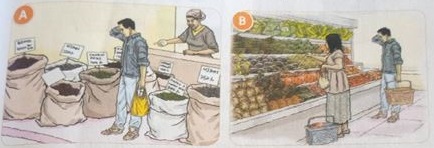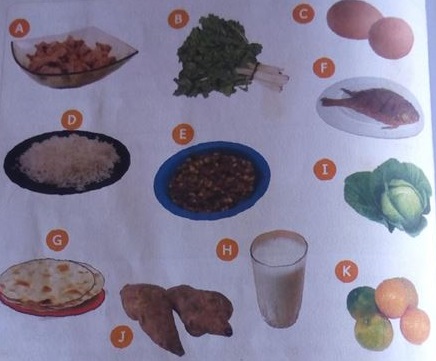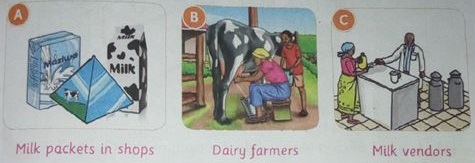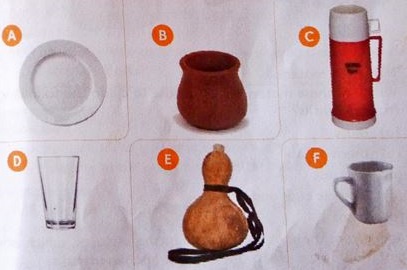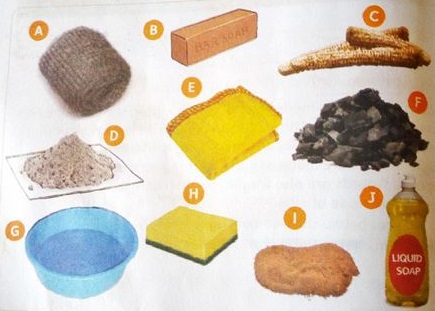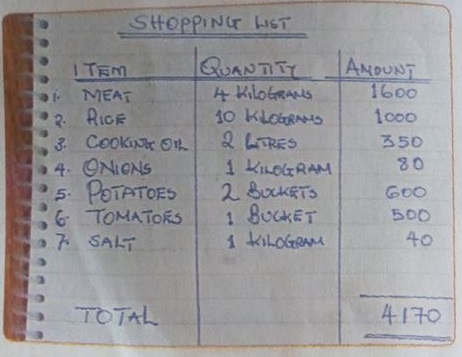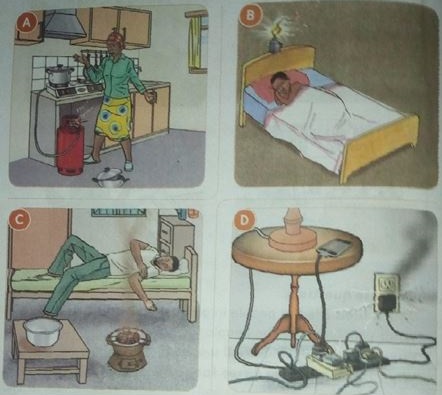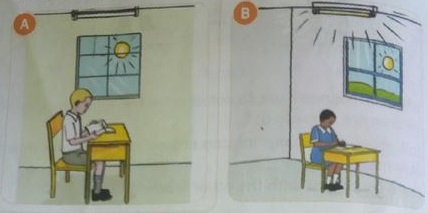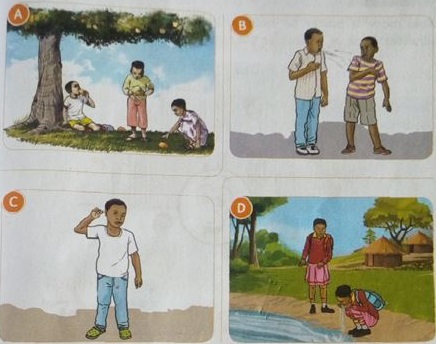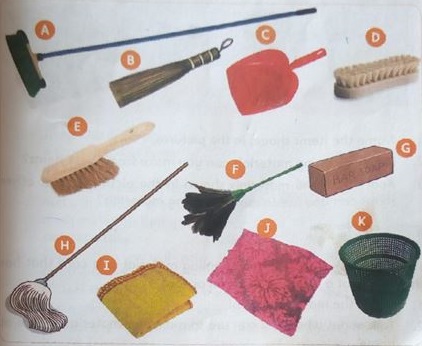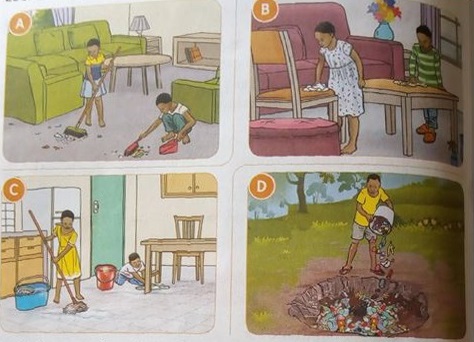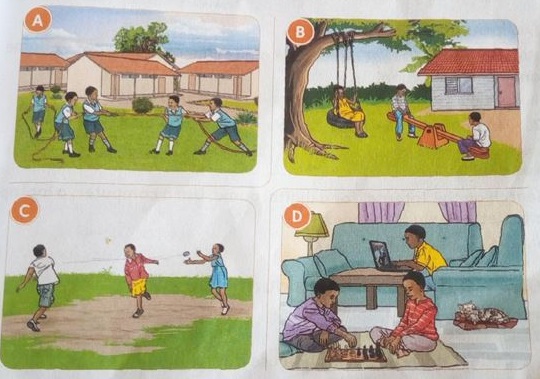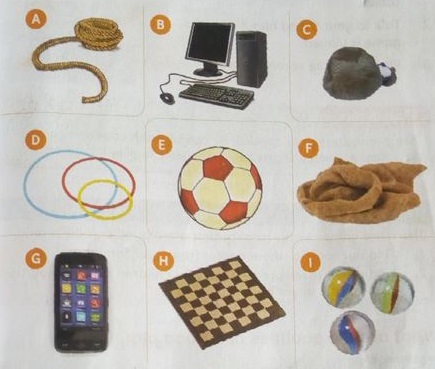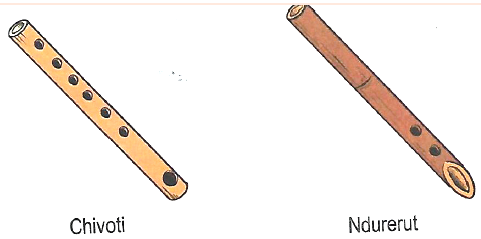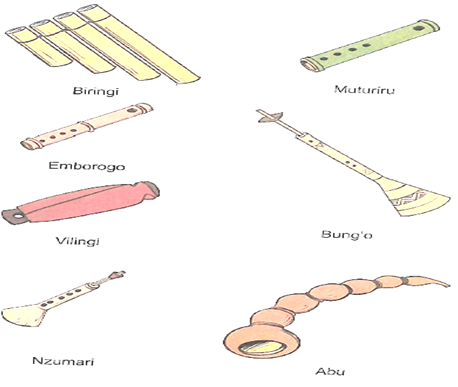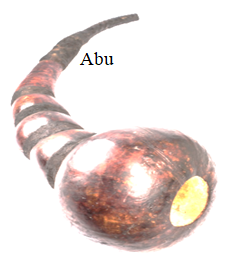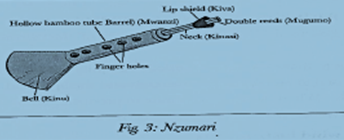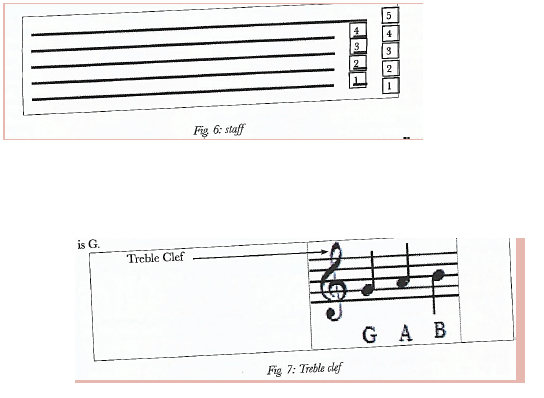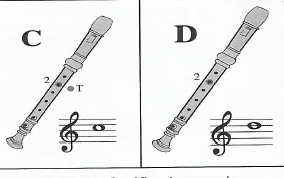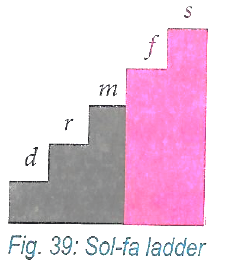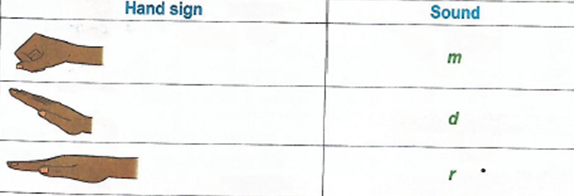Displaying items by tag: revision notes
Jesus Christ Our Leader- Grade 4 CRE Revision Notes
- Qualities Of A Good Leader
- Jesus The Perfect Leader {Micah 3:1-4, 1 Timothy 3:1-13}
- Accepting The Authority Of Jesus Christ.
Qualities Of A Good Leader
- Honest
- Without fault
- Orderly and sober
- Trustworthy
- Self control
- Able to manage family.
- Hospitable to strangers.
- Be a husband of one wife.
- Not greedy.
- Not a drunkard or violent
- Able to teach
- Mature in faith.
- Above reproach.
Jesus Christ As An Example Of A Good Leader {John 7:17, Matthew 3:13-17}
- Jesus was baptized by John the Baptist.
- He was baptized in river _________
- Jesus accepted to be baptized as a sign of obeying the will of God his father.
- When Jesus was baptized the holy spirit of God came in form of a dove.
- A voice was heard from heaven saying “ this is my beloved son in whom I am well pleased”
- Jesus did everything to glorify God.
Quiz- Name 5 qualities of a good leader.
- Jesus was baptized by _________
- He was baptized in river?
- The Holy Spirit came in a form of?
- The voice that was heard was from?
Jesus Christ Cleansing The Temple {Mark 11:15-18}
- Jesus went to the temple in _________
- Jesus was unhappy with those were selling
- Jesus used his authority to drive out people who were selling and buying in the temple.
- He said that the temple is a house of prayer.
Forgiving sins {Luke 5:17-25}
- Jesus was teaching people in a house.
- A paralyzed man was brought through the roof.
- Jesus healed him by forgiving his sin.
- The Pharisees were not happy that Jesus could forgive sins.
- Jesus used His power to forgive sins and heal the sick man.
Jesus Christ Sending the Twelve Disciples {Luke 9:1-6}
- Jesus had twelve disciples.
- Jesus taught them many things.
- Jesus wanted them to become God leaders.
- He sent them to go and preach the kingdom of God and heal the sick.
- He gave them power and authority to:-
- Drive out demons.
- Cure diseases.
- He told them not to carry anything.
- He told them to bless the homes they will be welcomed
- Where they were not welcomed they were to leave no blessings.
- The disciples were to rely on people they preached to to take care of them.
Jesus The Perfect Leader {Micah 3:1-4, 1 Timothy 3:1-13}
- Jesus was a perfect leader.
- He was obedient to God and had no sin
- He loved good and hated evil.
- He taught people to do good.
- He fed those who were hungry.
- He healed the sick.
- He delivered the oppressed for example those possessed by demons.
- Jesus was humble and had no pride.
- Prophet Micah warned those who were not fair and just to others.
- St. Paul also gave guidelines on how a good church leader should be.
Quiz- Jesus chased those who were buying and selling in the temple at _________
- Jesus fed the crowds with fish and _________
- Good leaders should follow the examples of _________
- Good leader should be of _________ character.
- Jesus Christ is the _________ leader.
Accepting The Authority Of Jesus Christ.
- Authority is the ability, power or right to give orders.
The Responsibility Of Church Leaders {Mark 8:1-9}
- Church leaders should accept the authority of Jesus by:-
- Be concerned about the needs of others.
- Be compassionate and loving
- Praying for the sick.
- Mobilize people to donate food for the hungry.
- Help in raising funds to educate the orphans.
- Mobilize people to donate funds to pay hospital bills for the sick.
- Offer guidance and counseling to the church youth.
Quiz- Jesus Christ used _________ and _________ to feed 4000 people.
- How many baskets were collected after feeding the 4000 people?
- Write things that show Christ was a responsible leader.
Following Jesus Christ {Mark 9:14-29, 1 Timothy 4:18}
- Following Christ is not always easy.
- Some of the difficulties in following Christ include:-
- People being cruel to them
- Lack of to do their work.
- Lack of shelter.
- Lack of food and clothing
- Lack of transport.
- Fear and lack of faith.
- The bible teaches us that
- We should follow Christ out of love and not out of fear.
- Fear makes it difficult for us to follow Christ.
- Christian’s should pray for enough faith to follow Christ.
Quiz- A boy brought to Christ by his father had _________ and spirit.
- Write two reasons why disciples were unable to heal the boy.
- The bible teaches us that there is no _________ in _________ .
- Perfect _________ drives out all _________.
- _________ makes it difficult for the followers of Christ to do their work.
- We should follow Christ out of _________ and not _________
How Good Leader Leads Us.
- A good leader is the one who guides people, serves them well and sets a good example.
- A good leader should desire to do excellent work
- Good leaders should:-
- Perfect in all things
- Sober and self-controlled.
- A husband of one wife.
- Gentle and peaceful.
- Hospitable
- Mature in faith
- Respected by people in the community
- A good leader is not a boss but a servant of the people.
Memory verse 1 timothy 3:1
“This is a true saying; if a man is eager to be a church leader, he desires an excellent work.
Quiz- Name 3 qualities of a good leader.
- Name 2 leaders in a church.
- In which book do we find the qualities of a good leader?
- Jesus had _________ followers.
- Name 3 things that a church leader should not do.
Jesus and Creation - Grade 4 CRE Revision Notes
The Effects Of Weather And Water
Genesis 7:11-24, numbers 20:2-6, psalms 104:10-14.
- Weather is the day to day change in the atmosphere.
- There are good effects of weather and bad effect.
- Good effects
- It helps crops to grow
- It helps to water land and prevent dust.
- It provides water for cooking, washing and drinking.
- Sun dries our grains, wind helps winnowing
- Bad effects of weather
- Flood destroys plants and crops
- Wind can destroy the roofs, draught dries crops.
- During the time of Noah, it rained for 40 days and 40 nights.
Questions
- Name the three sons of Noah
_________ ,_________ and _________. - Noah build the _________.
- Noah was _________ years when he started building the ark.
- Write down three bd effects of weather
- Write down 3 good effects of weather
The Miracles Of Jesus Christ
-
The feeding of 5000 people {John 6:1-13}
- Jesus fed 5000 men with two fish and 5 loaves of bread.
- After eating 12 baskets were left.
- The food belonged to a small boy.
- Jesus asked Philip where they will buy bread.
- Andrew said that there was a boy with 5 loaves and 2 fish.
- These miracles shows that Jesus cares for our spiritual and physical needs.
- Jesus has the power over nature.
-
The Raising Of Lazarus {John 38:44}
- Lazarus lived in Bethany.
- Lazarus had two sisters Mary and Martha.
- Lazarus died and was buried 4 days.
- Jesus raised Lazarus
- Christians should have hope of life after death.
-
The Miraculous Catch of Fish {Luke 5:3-11}
- Simon peter and Andrew had gone fishing in the lake of Galilee.
- Jesus asked them to throw their nest into water.
- Simon Peter believed and trusted God.
- They managed to catch 153 fish.
- The disciples were amazed at the miraculous catch of fish.
- Jesus showed that he had power over nature.
Quiz
- Jesus fed _________ people with_________ loaves of bread and _________ fish.
- _________ baskets remained.
- The food belonged to a _________
- _________ and _________ were the sisters of Lazarus
- Lazarus and his sisters lived in _________
- Lazarus was dead for _________ days.
- In the miraculous catch of fish, how many fish were caught?
-
The Calming Of The Storm {Luke 8:22-25}
- Jesus and his disciples were crossing the lake in a boat.
- A great storm suddenly appeared
- The disciples were terrified and woke Jesus up.
- Jesus Christ ordered the wind and the storm to calm down.
- Jesus asked the disciple why they did not have faith.
- The disciples were amazed.
- This shows that Jesus has power over nature.
-
Walking On Water {John 6:16-21}
- Jesus and his disciple were on a boat going to Capernaum.
- Jesus failed to turn up, the disciples decided go to Capernaum
- As they were sailing they saw Jesus walking on water.
- They thought it was a ghost.
- Jesus told them not to be a afraid
- Jesus got in the and they sailed on.
- This shows that Jesus has power over nature.
The response to the power of Jesus Christ.
- God created everything through Jesus Christ.
- Jesus has power over all that God created.
- We should respond to the power of Jesus Christ by:-
- Reading the bible
- Obeying God’s commandment.
- Trusting and believing God’s word.
- Showing love to God and others.
- Helping the needy.
- Living in peace with neighbours.
- Taking care of God’s creation
Quiz
- _________ and _________ were the sons of Zebedee
- By raising Lazarus, Jesus showed that he had power over _________
- By calming the storm, Jesus showed that he had power over _________
- By feeding the 5000 people, Jeus showed he had power over _________ .
Foods and Nutrition - Grade 4 Home Science Notes
- Choosing Foods
- Variety in the diet.
- Preservation Of Milk.
- Fragile Kitchen Utensils.
- Cooking Food.
Choosing Foods
What items do we buy from a general grocery?
- A general grocery is a shop that sells food items and small household goods.
- A grocery shop that sells fruits and vegetables is known a green grocery.
What do we consider when choosing foods from a general grocery?
- The type of material the packaging is made of
- The weight of the item that has been packaged
- The price of the item that has been packaged.
- The date of expiry written on the package.
Exercise
- You have ksh 500 to buy the items below at the nearby grocery shop
1 packet of maize flour at Kshs 120,1 litre milk at Kshs 60, 1 loaf of bread at Kshs 50 and 1 bunch of spinach at Kshs 10 each.- Prepare a shopping list.
- How much money will you use to pay for all the items?
- When receiving your balance, the grocery gives you ksh 20 more. What should you dowith the extra ksh 20?
- What would you look for when buying a packet of maize flour from a grocery shop?
- Write two things that would happen if there was no grocery shop in your village or town.
Variety in the diet.
What foods are available in our locality?
- The pictures below show the foods that are available in our locality.
How do we classify foods?
- Foods can be classified into three groups
- Foods that give us energy
Potatoes, maize, rice, yams, ugali, sorghum. - Body building foods
Meat, chicken, fish, beans, milk, green gram - Protective foods
Mangoes, oranges, kales, spinach, cabbage, kunde, managu
What is variety in the diet?
- Variety in the diet means eating foods from the three food groups.
- A healthy meal has variety. It contains foods fry the three groups in the right amount. This is called a balanced meal or a balanced diet.
Exercise
- Who am I?
- I am oval in shape and white in colour can break easily.
- You give me to babies. I am good for your teeth too.
- Monkeys love to eat me. I turn yellow when I am ripe.
- Look at the list of food items below.
Cassava, groundnut, watermelon, beans, orange, potato, water
Pick one food item to complete the form groups given below.- Ripe bananas, cabby, apple,______
- Rice, ugali, chapati,_______
- Meat, fish, milk,__________
- What is a balanced meal?
- Amoit loves to eat chips and sausages, and to drink soda. She is very happy with her choice of food.
- Is there variety in Amoit's meal? What is missing?
- Do you think Amoit has chosen healthy food to eat? Why?
- What would you choose for Amoit to eat?
Preservation Of Milk.
What are the sources of milk in our locality.
- We get milk from various sources in our locality. We get milk from vendors, shops and dairy farmers.
Why do we preserve milk?
- Fresh milk should be preserved because it goes bad easily
- When it goes bad, it goes to waste.
Reasons for preserving milk.
- To prevent it from getting spoilt.
- To prevent wastage
- To make it last longer
- To make it easy to store and transport.
How do we preserve milk?
They are different methods of preserving milk.
- Boil the milk. Boiling kills germs that make milk to go bad.
- Put the milk in a refrigerator. The low temperatures prevent the milk from going bad.
- Ferment the milk. Fermented milk can be used for a longer time than fresh milk.
- You can also use a home made cooler to preserve milk.
Using different methods to preserve milk.
-
Preserving milk by boiling it.
You will need: a clean sufuria, a jiko, fresh milk and a sieve.- Sieve the fresh milk into a clean sufuria.
- Light the jiko and place the sufuria the fire.
- Heat the milk until it starts to rise.
- Lower the heat and let the milk boil for about one minute.
- Remove the sufuria in a clean place and let the milk cool.
- Once the milk is cool, cover it with a lid.
-
Preserving milk by fermenting it.
You will need: fresh boiled milk, a gourd or a plastic container.- Pour the fresh milk in a gourd or plastic container plastic container.
- Cover the mouth of the gourd or the container tightly using a lid or cock.
- Keep the container or the gourd in a warm place.
- Do not disturb the milk for around two days to allow it to ferment.
- Shake it before you serve it.
Exercise
- Name the sources of milk in your locality.
- Why do we preserve milk.
- Name two uses of milk in our bodies.
- The pictures below show some methods of preserving milk.

- Name the methods.
- How does each method help to preserve the milk?
Fragile Kitchen Utensils.
What are the uses of the various kitchen utensils?
Which kitchen utensils are fragile?
- Kitchen utensils are made from different materials. Some kitchen utensils break easily. Other kitchen utensils do not break easily. Utensils that break easily are called fragile utensils.
- Fragile utensils are made of glass, earthenware and ceramic material.
- Gourds are also fragile. Earthenware and ceramic utensils are made of clay.
- The pictures below show some fragile kitchen utensils.
Which materials do we use to clean fragile kitchen utensils?
- How do we clean,dry and store glasses and thermo flask?
Cleaning a glass
- You will need: a glass,a ponge,sisal fibre or a soft cloth,two basins, warm water,a dish cloth,dish rack.
Procedure
- Put some warm water in a basin
- Wet the glass and sponge.
- Apply some soap on the sponge.
- Wash the glass gently in the warm water. Scrub the inside and outside of the glass.
- Rinse it properly in clean water.
- Wipe it using a dish cloth so as to make it shine. You can also place the glass upside down on a dish rack to dry.
- Store the glass safely in a cupboard.
Cleaning a thermo flask
- You will need: a thermo flask,a sponge,a soft cloth,two basins, soap,warm water, dishcloth and a dish rack.
Procedure
- Put some clean warm water in a basin.
- Apply soap on a sponge,sisal pad or soft cloth and put it in the flask
- Pour some of the warm soapy water in the flask and shake it gently.
- Pour the soapy water and the sponge back in to the basin
- Scrub the outside of the flask and the mouth of the flask, clean the lid.
- Rinse the flask and the lid in clean warm water.
- Dry the flask on a dish rack
- Store the thermo flask safely in a cupboard once dry.
How do we clean,dry and store earthen and ceramic utensils?
- How to clean a clay pot.
You will need: a basin,warm water and a sisal pad or a dry maiza cob.- Put some water in the pot .Leave it in the pot for a few minutes to sock.
- Scrape off the food remains using a sisal pad or a dry maize cob.
- Pour out the dirty water.
- Put some clean water in the pot.Scrub the inside and then the outside of the pot using a pad of sisal fibre.
- Rinse the pot using clean warm water.
- Dry the pot upside down on a drying rack.
- When it is dry ,store it upside down on a storage rack, or keep it standing in a safe corner.
- How to clean a ceramic cup
You will need: a ceramic cup, soap,a sponge,a soft cloth or a pad of sisal fibre,warm water,two basins and a utensil rack.- Put some clean warm water in a basin
- Apply some soap on a sponge
- Dip the cup in warm water. Use the sponge to gently scrub the cupon the inside and on the outside.
- Rinse the cup properly in Clean warm water.
- Dry the cup on a rack
- Once it is dry,store it safely in a cupboard.
- How to clean a gourd.
You will need: a gourd,warm water,a basin, small stones and a sponge or sisal pad.- Put some small stones in the gourd.
- Add some clean warm water.
- Shake gourd gently several times.
- Pour out the water and the small stones.
- Scrub the outside of the gourd with a sponge or sisal pad.
- Rinse the gourd with the warm water until it is clean
- Dry the gourd upside down on a rack. Ensure it is safe.
- When it is dry,store it on a rack ,or hang it on a wall using string.
Safety when cleaning fragile utensils.
- Handle fragile utensils with care.
- Do not stack glasses
- Wash one utensils at a time
- Wash the utensils using a soft material.
- Do not put glasses in very hot water.
- Do not use soap when cleaning clay pots and gourds.
- Always dry gourds and earthen utensils well before storage.
- Store fragile utensils safely away from the reach of children.
Exercise
-
- Name three fragile kitchen utensils you use at your home.
- Write two things you should do when cleaning glasses to make sure they do not break
- You have been asked to show the Learners in your class how to wash a glass.
- Write down three materials you will use
- How will you reuse the water after washing?
Cooking Food.
Why do we cook food?
- We cook food to become soft
- We cook food so that it can be easier to eat
- We cook food for easier digestion
- We cook food for it to taste good
- We cook food to kill germs
- We cook food for it to last longer.
What hygiene practices should we observe when cooking food?
- Wear clean clothes when cooking.
- Cooking food properly
- Washing hands before touching Food.
- Covering head with a cap and wear on apron.
- Cook and serve food in Clean utensils.
- Cover cooked food and keep it in a clean place.
Consumer Education - Grade 4 Home Science Notes
Consumer Awareness.
What is a shopping list?
- When you want to shop, you should first prepare a list of all the items you want to buy. This list is known as shopping list.
Why is a shopping list important?
- It saves money by helping a person to buy only the things they need.
- It saves time when shopping. This is because a person knows exactly what to buy.
- It reduces by helping a person to choose items that are most important.
- It enables a person to know the amount of money he or she needs to buy the items.
What are the steps of making a shopping list?
- Think About all the things you want to buy
- Consider the money you have
- Think about important items and the less important items
- Write your list, starting with the most important items.
- Write how much each item costs.
Exercise:
- Barry wanted to do shopping. He wrote the following items on a piece of water.
- Cabbage
- Tomatoes
- Potatoes
- Onions
- Sukuma wiki
Where should Barry go to buy the items.
- Write down three important reasons why one should make a shopping list.
Fuels - Grade 4 Home Science Notes
Fuels used at home.
Which types of fuels are available in our homes?
- Fuel is any material that is used to produce heat or light in our homes. Charcoal, firewood, paraffin,gas and electricity are fuels.
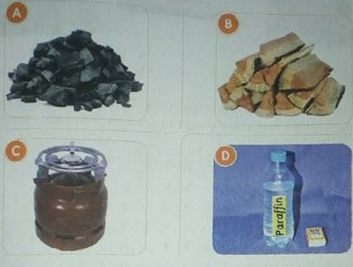
Why do we use charcoal at home?
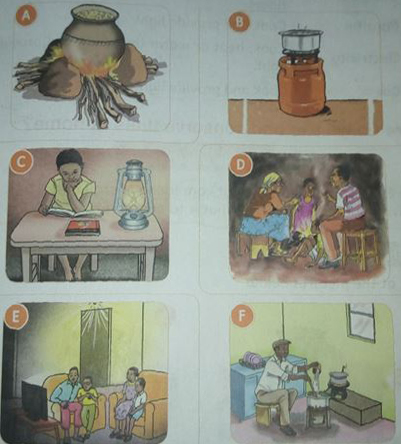
- We use charcoal in our homes for various purposes
Fuel What we can use it for Firewood Cook,heat or warm the house and provide light Charcoal Cook and provide heat or warmth in the house Paraffin Cook and provide light Electricity Cook,heat or warm the house and provide light Gas Cook and provide light
How do we use and conserve fuels at home.
To conserve something is to use it without wasting. Using fuel without wasting it is conserving fuel.
- We can conserve firewood and charcoal by using jikos that use less firewood or charcoal.
- We can conserve electricity by using energy saving bulbs, and using electricity only when we need it.
What challenges can we face when using fuels?
- Some fuels are dangerous and can cause fire,like firewood.
- Some fuels produce so much smoke that is dangerous for our health.
- Fuel like gas can get finished before you start Icooking.
- Electricity is very unreliable as it can be off without notice.
How do we keep safe when using fuels.
- Do not overload sockets
- Check the gas cylinder and pipes to ensure they are not working.
- Do not sleep in a closed room that has a burning charcoal jiko.
Exercise
- Name any three fuels you see at your home.
- A grade four Learner used charcoal for cooking.How else can this Learner use charcoal?
- Look at the pictures below.
- Who is using fuel well in the pictures?
- Who is wasting fuel? Why?
- Write three ways we can conserve firewood at home.
- When using gas, what safety measures should you think about?
Healthy Living - Grade 4 Home Science Notes
Common Illness In The Locality.
What are the common illness in our locality?
- There are common illness that affect people in our locality.
- These illness can cause headaches, vomiting, stomachache and general pain in the body.
- They can also make us feel hot or cold.
How do we communicate when feeling unwell?
- We should always tell other people when we feel unwell.
- We can tell our parents,our teachers,our friends or a responsible adult.
- When we tell other people that we feel unwell,we get help
What are the causes of illness in our locality?
The common illness in our locality are caused by:
- Germs- eating using dirty hands or eating fruits without washing.
- Coughing without covering your mouth will spread diseases to others
- Putting sharp objects in our ears or nose
- Drinking dirty water also causes diseases like cholera.
What healthy practices prevent illnesses?
- Washing hands—wash your hands using clean running water.
- Covering the mouth when coughing—cough while covering your mouth.
- Using a handkerchief—clean your nose using a handkerchief.
Exercise
- Name three common illness that affect people in your locality.
- Mrefu went to school. During break time,he developed a headache.He told his teacher. His teacher took him to hospital.
-
- write what you think mrefu told his teacher.
- Write what you think mrefu told the doctor at the hospital.
- Shantel and Rayan were given fruits by their father. Shantel washed her fruits before eating. Rayan ate his fruits without washing them.
- who among the two practised a healthy habit? Which healthy habit was practised?
- write other heay practices we should practice.
Care Of The Home.
What do we use to clean our home?
- Things we use to clean our home are: brooms,dusters,soap,moppers, brushes,dust pans and dust bins.
- We sweep and mop floors,dust surfaces and dispose refuse to keep our homes clean. We use different materials to do these tasks .
What are the methods of cleaning the home?
The different methods they we use to clean the home are:
- Sweeping
- Dusting
- Mopping
- Disposing of refuse
How do we clean our home?
Activity 1.
- You will need: brooms, water,soap,mops or floor cloths,basins or buckets,dustpans and cloth dusters.
- Sweep the class. Dispose of waste in a dustbin and take it to the rubbish pit.
- Dust the windows,chairs,tables and desks.
- Mop the class allow it to dry.
- Arrange the furniture after cleaning.
- Clean and store the cleaning materials and tools properly.
Safety precautions when cleaning a room
- If the floor is earthen,sprinkle water on it before sweeping.
- Wear an apron and a dust mask when sweeping yor dusting.
- Avoid walking on a wet floor.
- Wait for the floor to dry before arranging the furniture.
How do we care for and store cleaning materials and tools
- Hang brooms and mops or place them against a wall on the handle.
- Store brushes on a shelf with the bristle facing up
- Keep basins and buckets in a shade
- Hang dust pans by the handle.
- Fold floor cloths and store them on a shelf.
Exercise
- Write five materials we can use to clean our houses.
- Name four locally available materials we can use to make cleaning materials and tools
- Your teacher has asked you to show other Learners in your school how to clean their homes.Write down what you will tell them about being safe when cleaning their homes.
- Why do we close windows and doors when sweeping and open them after we have finished sweeping.
- You have been asked to mop your house.Write three materials you will use. How will you use them?
Care And Cleaning Of Shoes.
What materials are our shoes made of?
- Shoes are made from different materials. They can be made from leather, plastic or canvas.
What materials do we use to clean our shoes?
- Materials used to clean shoes are:
- Shoe brush
- Shoe polish
- A piece of cloth
- Water and soap
- A piece of stick
- Old newspapers
How do we clean leather shoes?
- Materials needed:
- Leather shoes,shoe polish,two shoe brushes,a piece of cloth,warm water, soap,a blunt stick,a basin or a bucket and old newspapers.
- Procedure:
- If necessary, cover the surface with old newspapers.
- Remove any mud from the soles using a blunt stick.
- Dispose of the old newspapers and the mud appropriately.
- Wipe the shoes using a piece of cloth to remove any dust
- Remove the shoe laces,if any.If the shoe laces are dirty ,wash them in soapy water,rinse them and hang them to dry.
- Wipe the shoes with damp cloth dipped in soapy water. Wipe the shoes again using a clean damp cloth. Leave the shoes to dry in the shade for a few minutes.
- Apply shoe polish using a soft shoe brush.Allow the polish to soak in for a few minutes.
- Brush the shoes in a dry airy place.Stuff them with newspapers if storing them for a long time.
How do we clean plastic shoes?
- Materials needed:
- Plastic shoes,a piece of cloth or a soft brush,warm water,soap,old newspapers,a blunt stick and a basin or a bucket.
- If necessary,cover the surface with old newspapers
- Remove any mud from the soles using a blunt stick.
- Dispose of the old newspapers and the mud appropriately.
- Put some warm water in a basin or bucket.
- Add some soap and stir.
- Dip the shoes in the soapy water.Scrub them using a cloth or a soft brush.
- Rinse e shoes well in clean water.
- Dry the shoes in the shade.
How do we clean canvas shoes?
- Materials needed: Canvas shoes,soap,water,a basin or a bucket,soft brush or a scrubbing cloth.
- Remove the shoe laces if any. Wash the shoe laces in soapy water if they are dirty.Rinse them and hang them to dry.
- Remove any mud from the soles using a blunt stick.
- Hit the shoes gently against each other to remove I dust.
- Remove the insoles from the shoes.
- Wash the shoes and insoles in warm soapy water. Scrub them with a cloth or a soft brush.
- Rinse the shoes and the insoles in Clean water. Shake them to remove excess water.
- Dry the shoes by placing them against a wall in a slanting position.
- After they dry ,put the laces and insoles back and store the shoes in an airy place.
- Put some newspapers in the shoes to prevent them from losing shape.
How can we observe safety when cleaning shoes?
- Use a blunt piece of stick to remove mud. Do not use a sharp one.
- Use warm water when cleaning. Do not use hot water.
- Store cleaning materials in a locked place
- Store shoes properly after cleaning.
How do we care for and store the materials we use to clean shoes?
The following are some ways of taking care of the materials we use to clean our shoes.
- Store shoe polish on a shelf away from small children.
- Store shoe brushes on a shelf with the bristle facing up.
- Clean the scrubbing brush and store it on a shelf with the bristles facing up.
- Wash the cleaning cloth in soapy water and dry it.Fold and store it on a shelf.
- Wash basins and buckets and store them in a shaded area.
Exercise.
- Write the materials used for making shoes.
- Your parent has asked you to clean your canvas shoes.Write down the Materials you will use
- How do we take care of basins and buckets after cleaning our shoes.
- You have been asked to teach other children how to clean their shoes.Erite two safety measures you will tell them to observe when cleaning their shoes.
- Why are shoe brushes stored with the bristles facing up?
Healthy Practices - Grade 4 Home Science Notes
Play
- To grow healthy,we need food, clothing,play,rest and shelter.
- Shelter is housing.
Which games are played in our locality?
- Games played in our locality are football, Athletics,tug of warm, swinging, playing darts, playing games on computers.
Which items do we use during playing?
- Items we use when playing are;
- Ropes, computers,bean bags,balls,sacks,phones,mats and marbles.
What are the qualities of a good play item?
- Should be durable
- Stronger
- Should be smooth not rough that can hurt people
- Should be safe to play with
How do we make play items?
- Making a ball using locally available materials.
- Materials needed:
- Pieces of cloth or old newspapers,an old clean sock and string
- Procedure:
- Take the old sack
- Put pieces of news paper or cloth in the old sock. Push them to the Bottom of the sock.
- Mold the pieces into the shape of a ball.
- Twist the sock and turn the top side inside out. Tuck in the ball.
- Tie the end with a string or make a note.
How do we take care of our play items?
- Play items should be kept well after use.
- Arrange them well on the shelves or put them in cartons neatly.
- Always keep them in a clean dry place.
Safety and security during play.
- Remove items like stones,sticks, and broken glass from where you are playing.
- Avoid playing near dangerous areas like water pools and holes.
- Do not play with damaged play items
- Do not play with dangerous objects.
- Never push other children out of a game. Always wait for your turn.
- Always keep your play items safely after playing.
Exercise
-
- write down three things you need to grow healthy
- Write down why each of the things is important.
- Your teacher has asked you to bring the following materials to class.
Old pieces of clothes,a string, a rope, green sticks- Write three play items you can make using the materials.
- Which games can you play using the play items?
- Write two things we should think of when buying a toy.
- Make a poster on how we can prevent accidents during play.
Show your pooster to other Learners in class - Write three ways we should care for a ball.
Listening, Responding and Appreciation - CBC Grade 5 Music Revision Notes
Element Of Music
The following are musical instruments
Pitch – the highness or lowness of sound. The combination of varied pitches produces a melody e.g pitch pipe
Melody – should be done keenly as it is difficult to correct once mastered. Use melodies or songs familiar for the start.
Dynamics – relates to the volume of sound. This can either be loud or soft. Dynamics influence the expressiveness in a performance.
Beat /Pulse – regular through of music. The following activity helps in identifying beat.
- Clapping/tapping
- Chanting the words of familiar songs rhythmically
- Conducting learners
Tempo – refers to pace or sped of music.
Activities such as clapping, tapping, marching can be use when teaching about tempo
Responses to tempo are communicated through by running, walking jogging, or skipping.
Mood- this involves feeling about the songs, whether happy or sad
Form – is the structure or shape of piece of music, it is dictated by the melody. The rhythms and repetition on the piece
It is always shown with letters such as //A// OT //B// or //AB//
Grade 5 focuses on //ab//. The part is always the stanza while the B part represents the chorus.
Kenya Indigenous Musical Instrument - CBC Grade 5 Music Revision Notes
Wind Instrument
- They are also called aero phones. They are played by blowing
These instruments have a permanent tuning which is acquired during construct - This is because upon constructions, wind instruments remain of fixed length, have a fix number of holes and a fixed blowing hole.
- They vary in shape, size and material used to make them. They are grouped in the following sub- classes”
- Horns- made from animal horns or natural hollow or hollowed out wooden tubes. Among some communities horns are joined to a gourd. E.g.
- Oluika- luya
- Lalet-kalenjin
- Oporo/tung’-Luo
- Coro-kikuyu
- Kikundit-kipsigit
- Adet-turkana
- Aluti-Teso
- Flutes-Are made from materials such as bamboo, swamp reeds, twig or wooden tubes. Currently improvised using plastic tubes.
Flutes vary in length and number of finger / pitch holes from one community to another.
Other features that can be used to distinguish or differentiate flutes are:
- closed at both ends
- Open at both ends
- Open at one end and closed at another end
- Notched at the blowing end (part of the end is v-shaped)
- Round at the blowing end
- End blown (also oblique)
Side blown (also traversely blown-this means the blowing hole is at the side of the flute.)
Indigenous flutes from the diverse Kenyan communities include:
End blown flutes (oblique)- Muturiri-Gikuyu
- Auleru-Teso
- Asili/Odundu-Luo
- Ndererut-Kalenjin
- Ebune/Elamaru-Turkana
Traversely held flutes - Chivoti-Digo, Rabai, Duruma
- Ekibiswi-Kuria
- Emborogo-Kuria
- Umwere-Kuria
- Mulele-Luhya
- Whistles – these wind instruments are made from hollow tubes or reeds which are bound together. The different length makes it possible to produce different varied pitches when the instrument is blown e.g. biringi of Agikuyu, vilingi of the Akamba.
- Reed instruments – double reed instruments have two reeds at the mouthpiece which is made from reeds. The two reed instruments have a tip shield made out of a coconut shell of metal coin
The lip shield- holds the reed in place and prevents air from escaping. The reeds vibrate when air is blown into the instrument thus producing sound. The Nzumari and the Bung’o played among some of the mijikenda community such as Digo and Rabai.
Functions of parts of flutes
- Bamboo reed - this is the main framework of the instrument and it also serves as the resonator
- Blowing hole – it is a hole through which air is blown causing the production of sound
- Pitch hole – are closed and opened with alternating finger movements to produce varied pitch when playing the melody.
- Closed – end = this part direct the sounds towards the open end.
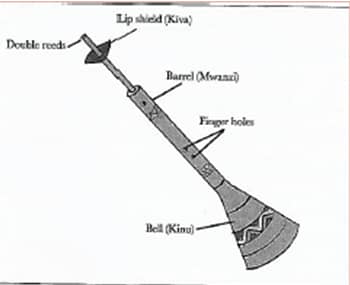
FUNCTIONS OF THE PARTS OF REED INSTRUMENTS
- Hollow bamboo reed – this is the main body of the instrument which act as a resonator
- Bell - it is used to make the sound louder or amplify the sound
- Neck - use to attach the double reeds and the lip shield
- Double reeds - when blown, they vibrate to produce sound
- Lip shield – this is where the lip rest when blowing
SKILLS OF PLAYING WIND INSTRUMENTS
- Some are held traversely while others are end blown
- Positioning of the lips – the lower lip is placed on the lower part of the blowing hole
- Blowing- air should be blown across the blowing hole. The amount of air being blown depends of the wind instrument.
- Tonguing - the tongue is used to put the accent on
- Fingering – closing and opening of finger holes in an alternating manner assist to produce varied pitch.
- Breath control – it’s also referred to as phrasing and should be done at appropriate places when playing the wind instrument.
Western Musical Instrument
Descant Recorder
Recorder fingering chart
Skills of playing the recorder
- Posture – correct poster will help in breathing deeply in order to get good sound out of the recorder.
- Breath control – enables them to achieve the good phrasing when playing the descant recorder.
- Holding – should be held properly with both left handed and right handed learners. The recorder is end blown.
- Embouchure - refers to the position and the use of the lips and teeth in playing wind instrument. It includes shaping the lips to the mouthpiece of the musical wind instrument
Embouchure is important because it affect the production of quality of sound - Articulation – (preparing the tongue) air flow is critical to the production of good tone or sound on the descant recorder. Blowing too much air will leard to production of squeaking sound.
- Fingering – the left hand should be placed in the first three holes, while the right hand should be placed in the rest of the holes. Holes should be covered completely, failure to which will cause air to escape and a squeaking sound will be produced.
When holes on the descant recorder are covered completely, small round marks will be imprinted on the fingersTHE NOTES B, A AND G
They are played using the left hand and are organized logically with fingers moving in a sequential order.
Music Staff Notation
THE STAFF- this is a set of five parallel line and four spaces on which music is written.
The lines and spaces are named using the seven letters of the English alphabets A,B,C,D,E,F, and G.
Naming is made possible using clef. The treble or G clef is used to establish the pitches of the staff
Music for the descant recorder is written on the staff using the treble Or G clef.
Fingering notes is illustrated below
NEW NOTES C AND D
- They are fingered using the left hand as shown below
- The left hand thumb hole is left open when playing the note D
Kenyan Folk Dances
Dance - a form of art involving rhythmic movement’s f the body in response to music
It is an expression of norms, values, belief, attitudes and customs of the community.
In traditional African society dances are for specific groups of the performance e.g. boys, girls, boys and girls, young women and
Categories of participants
- Soloist – introduces dances, it is also known as Solo choral response or call response singing.
Roles of a soloist- Starting the dance
- Ending dance
- Help capture the message and the mood of the dance
- Pitching the dance songs
- Cuing dance on the change of melodies, movements and dance formations.
- Dancers – perform dance movements, create formations
- Dancers – perform dance movement. create formations
- Lead dancers – remind dancers the next dance style and formation. Guide other dancers in creating the varied dance styles/movement and formations to ensure transitions to ensure transitions are smooth.
- Singers - respond to the call of soloist. Make performance lively. Communicate the message and the mood of the dance
- Instrumentalist – make the dance performance lively.
Melodic instrument helps in pitching the performance.
Help in keeping the steady beat of the songs.
Assist to cue singers and dancers on the change of melodies, dance styles and formations to ensure smooth transition.
Provide rhythmic and melodic support to the rhythms and melodies in dance. - Audience and onlookers – make participants feel appreciated
Their participations bring the dance to life
Costumes
This involves styles of dress or clothes worn by the participants in dance performance. Roles of costumes in dance performance include:
- To depict the cultural community it is drawn from.
- To adorn the participant
- To distinguish the different roles played by various participants of the dance
- Influence the participant level of confidence
- Allow dancers or the wearers freedom of movement and formation
- Give information about certain role or characters due to elaborate details of the costumes
- They give the participant of the dance aesthetic appeal
- Are associated with the costumes and habits of a group of people
- Gives the participant dignity
- Help the identify the community the song originates from
- Create uniformity among the participant
- In modern times dance performance use uniform costumes made of sisal and banana leaves
- In each community there are items of value which the participants use during dancing. These items are also known as artifacts which includes shields, swords, skis and traditional tools.
Body Adornment
- It is an art which involved decorating the body, these vary across communities and can be permanent or temporary
- Permanent body adornment is done by piercing, scarification or tattoos, both are used to enhance beauty and also have social and ritual significance
- Some adorn using temporary designs using pain, ochre and henna to decorate the skin. The decoration can symbolize a variety of meaning e.g. social, economic or marital or even political status of the wearer.
- In some communities it is used to enhance the feminity or masculinity of an individual.
- The most common method used nowadays is by water emulsion pain
The type of body adornment used is influenced by the occasion /event or an individual’s stage in life.
Ornaments
Are accessories, articles or items used to add beauty or decorate the appearance of the participants in dance.
In some communities’ beadwork is an integral part of making ornament, beads used in making ornaments can vary in shape, size and colour. The ornaments include.
- Earring
- Armlets/armbands
- Anklets
- Necklaces
- Feathers
Creating /composing
Is a succession of sound with long, short or equal duration. It is the pattern of the music in a given time. It can exist without a rhythm.
The long and short the French rhythm names are used to create different rhythms and represented by different matching symbol. These musical symbol are the musical notes.
| French rythm name | Length of sound |
| Taa | 1 long sound |
| Ta-te | 2 long sounds |
| Taa-aa | 2 long sounds |
| Taa-aa-aa-aa | 4 long sounds |
| French rythm name | Note symbol | Note name | Length of sound | Number of beats |
| Taa | |
Crochet | 1 long sound | 1 beat |
| Ta-te | |
Quavers | 2 long sounds | ½ a beat for each quaver |
| Taa-aa | |
Minim | 2 long sounds | 2 beats |
| Taa-aa-aa-aa | |
Semibreve | 4 long sounds | 4 beats |
Words have their natural speeches style which dictates whether to be given either along or a short beat. Syllables in words can be stressed while others are not.
The stressed syllables occurs as strong beats while the unstressed syllables as week beats.
The beats are divided into groups of two beats, three beats or four beats
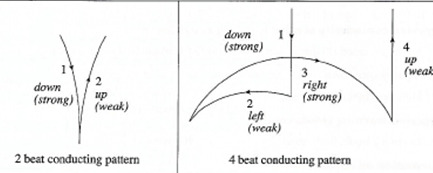
Melody
Is a sequence of pleasant sounds that makes up musical phrase
It is a tune that sound nice or pleasant to the ears
An understanding of high and low sounds is essential in identifying melodic variations within a song. Variation to simple melodies can be created by
- Repetition
- Changing doh
- Changing rhythms
- Changing note
- Changing words
Hand Signs
It is a good way of understanding and recognizing pitch. These are gestures used to indicate pitch in sol –fa.
When using hand gestures to guide the pitch of the ‘’doh’ is movable (it is not fixed)
Hand signs showing sol-fa syllables
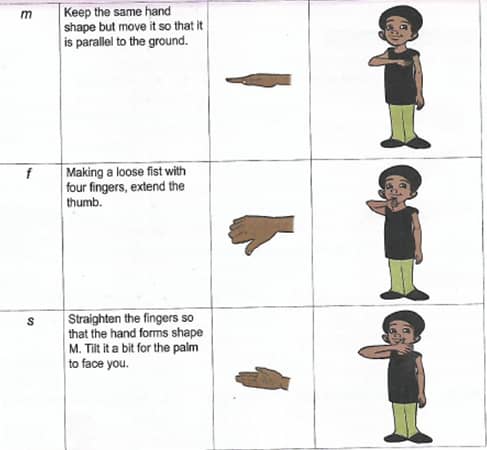
Hand signs showing sol-fa syllables
Performing - CBC Grade 5 Music Revision Notes
Songs
Repertoire - This is a wide collection of songs. It varies in language, events or occasions and activities relevant to the learners.
There are various categories of songs to be learnt in Grade 5
They include
- Religious songs
- Patriotic songs
- Topical songs
- Popular songs
The criteria for choosing songs should include
- Simplicity in text and, rhythm and melody
- Stepwise movement of melodies
- Call and responsorial.
- Songs with catchy appealing melodies.
- Strophic infrastructure (songs with different verses which are sung to the same music).
- Full appropriate activities / actions for the learners.
Types of Songs
- Patriotic songs – They are sung in praise of a county and its leaders. They emphasize on patriotism and social cohesion eg Kenya, Kenya Taifa Leo.
- Topical songs – they are used to convey special message on pertinent and contemporary issue. These include safety, personal hygiene, health and nutrition, importance of education environmental conservation and values. Corona Ni Atari, wash your hands.
- Religious / sacred songs – They are imposed for religious purpose e.g. Christianity, Islam and Hinduism use their sacred songs to worship and praise a divine.
- Popular songs – They have great appeal to listeners. Such songs cause an audience to easily dance or sing along. The lyrics. Rhythm, melody or genre can influence the popularity of the songs.
The East African Anthem
- It is also known as wimbo wa Jumuiya ya Africa Mashariki in Kiswahili
- It has three verses which are sung in Kiswahili
- It is also commonly or simply referred to as EACA (EAST AFRICAN COMMUNITY ANTHEM)
- The anthem is sung among the east African community members states namely: Kenya, Rwanda, South Sudan, Tanzania and Uganda.
- The music of EAC anthem is presented in two scores namely:
- A choral music score written for Soprano, Alto ,Tenor and Bass
- Brass band music score written for the western brass musical instrument.
- In grade 5 it is limited to being sung in unison using Soprano melody.
- It is to be sung once the East African Communities has been hosted in all government and public learning institutions in Kenya.
- Both the Kenya National Anthem and the EACA should be performed at public events with the aim of boosting the East African Community integration and also as a symbol of unity among the East African community member states.
Guidelines of Performing the EACA
- During and the occasion of the performance, everyone present should stand to show a sign of respect.
- EACA citizens shall sing or play the anthem during the occasions or regional significance.
- Individuals playing or singing the EACA should ensure that the tune and the lyrics (words) are sung with the dignity it deserves.
- Either the instrumental or sung version will be performed.
Occasions during which the EACA is performed
- During all the EACA summit meeting and commemoration days.
- During any occasion of the community where the head of the state is present, two verses of the anthem shall be sung or played
- Any other occasion
Skills and concepts to be developed in singing
Accuracy in pitch, rhythm and words should be observed while singing the various types of songs.
Learners should observe the natural speech rhythm of the words of the songs which define the rhythmic pattern of the songs
PART SINGING
There are indicators to show that learners are ready to sing in parts, they include:
- Singing in tune and unison without support of either the voice or instrumental accompaniment.
- Accurate imitation of melodic phrases and phrases and rhythmic patterns.
- Confidence while singing alone with others.
Questions
- Name three types of songs?
- Write occasions when patriotic songs are performed?
- When should the East African Community Anthem should be sung in Kenya?
- Write the Kenya National Anthem verse 1 in Kiswahili?
- Name any three voices in a three part song?
Kenya Folk Songs
- Singing is part and parcel of everyday life in any community. This habitual practice is deeply embedded in every cultural activity within the community.
- It plays and integral part in ritual and social event within a community.
- Folk songs are songs sung in particular community.
- It originates among the people of particular are or locality.
- They are sung in the local dialect or language of the community they originates from.
- The songs are handed down from singer to singe or from one generation to another by oral tradition
- Folk song starts at welcoming of birth once new born baby takes the first breath.
- As an individual, he or she celebrates rite of passage which introduce them to adult responsibilities as captured in work songs, wedding songs, initiations songs, praise songs and when an individual dies, dirges (funeral songs)
- The circumstance/events/occasions within which the folk songs are performed dictate the message, gender and aged of the participant.
- Folk songs tell stories, give a snippet of the past life and highlight various areas of life shared across the cultures and shed life don similarities between people.
Folk songs serve the following roles
- Preserves community culture
- Define cultural identity/helps to distinguish one community from the other.
- Used as a medium of communication
- Enhance or strengthen unity or solidarity within the community.
- Enhances conformity to social norms of the community.
- Creates/provides a medium forum of emotional expression
ASPECT OF FOLK SONGS
- OCCASIONS
life is punctuated by different events or occasions. The events are influenced by community tradition, customs and history e.g ritual and social occasions such as birth of baby, work, marriage, funerals initiations and religious ceremonies. Each occasion has its own special song. - MESSAGES
Folk songs play a communicative role. The various occasions dictate that the song sung have messages that are appropriate to the ceremony or event. The messages as communicated through text, dictate the mood of the folk songs.
Folk songs are appropriate and uphold community values, virtues, customs and norms - INSTRUMENTATION
Community diversity is also evident through the varied array of musical instruments.
In most community, musical instruments are used to accompany folk songs. Music instruments can either be melodic or rhythmic.
During the performance of folk songs, music instruments can be played for the following reasons:- To support the melody/tune
- To pitch the performance
- Make the performance interesting /lively
- To provide rhythmic support
- To fill up the interludes during the performance
- Help in keeping the steady beat
- PARTICIPANTS
Folk songs are performed in groups or as solo. Participants vary in age and gender. They include; soloist, singers and instrumentalist.
The occasions during which folk songs are performed influences the age group and gender of participants e.g. boys and girls, men and women
African folk songs are largely responsorial in style also referred to as solo choral response
A soloist can either be male or female. A good soloist should be confident and audible.
Roles of a soloist in a folk song
- Pitching singers so that they sing without straining
- To cue singers on the change of melody or body movements
- Address the audience while commanding singers
- To coordinate the movements during the performance.
The choral groups/response sings the same tune/ melody throughout the performance of folk song. This referred to as singing in unison
The vocal power of the choral response must match the vocal strength of the soloist
PERFORMANCE ETIQUETTE DURING FOLK SONGS
- Dress appropriately
- Talking – this distracts the performance
- Reactions to others - e.g. during a mistakes, it is wrong to stare, mock or boo.
- Maintain enough space between the participant to avoid collision
- Always accept and acknowledge the applause from any audience.
Questions
- The participant who leads a folk song is known as ………………..
- A folk song belongs to ………….. of community
- Name any other occasion when a folk song is performed.


